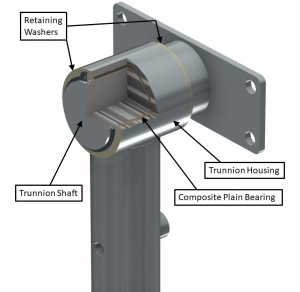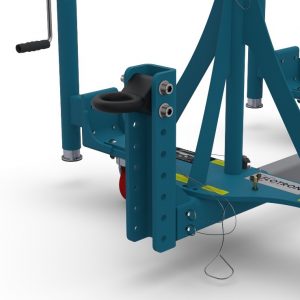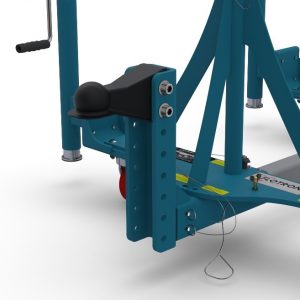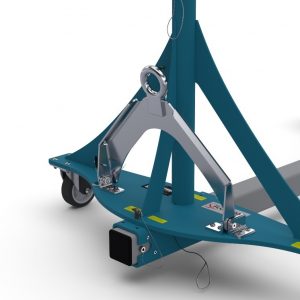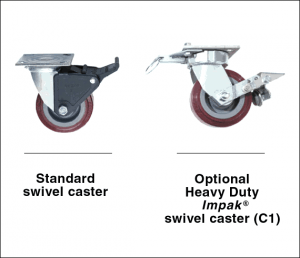SFP-655 Series Standard Options:
Optional Fixture Finishes (N), (C):
1. Electroless nickel plating (N): This option replaces all zinc-plated parts with either electroless nickel-plated parts or stainless steel parts.
2. Clean Room option (C): This option is identical to the (N) option but with the addition of electroless nickel-plating on the interior of the end frame slide tubes and vertical support tubes. The exterior of the gearbox, as well as the exterior of the end frames, are painted with high gloss urethane or epoxy paint in place of the standard textured enamel paint..
Optional Ground Lug and Drag Chain (E):
For use in electrostatically protected areas (EPA’s). Proper electrostatic discharge (ESD) grounding of the fixture must be a part of the overall EPA design. (See Technical section discussion on ESD..
Optional Lubricants:
Krytox GPL 207 (L1) – The trunnions and caster swivel bearings are lubricated with Krytox GPL 207. Note that this lubricant comes standard on “C” (Clean Room) finish and does not need to be specified.
Braycote 601EF (L2) – The trunnions and caster swivel bearings are lubricated with Braycote 601EF.
Forklift Tubes (F1):
Forklift tubes are bolted to the bottom of the end frames and span the length of the fixture. They are designed with a stiffener I-beam welded to the top of the forklift tubes so that the forks do not need to span the entire length of the fixture if long enough forks are not available. It is critical that the forks extend at least two feet past the combined fixture and payload CG. If you are unsure of how long the forks need to be for your application, please contact Flotron. The forklift tubes are only compatible with the SFP-645 & 655 series. See Proposal Drawing to see max adjustment range on nominal “B” distance. The forklift tube option can be retrofitted on existing Flotron Rotation Fixtures.
Optional Leveling Jacks (J1, J2, J3 OR J4):
Four bolt-on Leveling Jacks allow for leveling of load while in a stationary position. Orientation of jack handles relative to the frame must be specified. See the JACK HANDLE ORIENTATION TABLE below to determine which handle orientation suits your application. Codes J1 through J4 are shown. The Jacks have 1″ of rise for each 8 turns of the crank handle.
Optional Heavy Duty Gearbox:
1. Optional 60:1 ratio Single reduction Gearbox (SR): This gearbox offers heavier duty construction than the standard gearbox, plus low backlash and slightly more resistance to stair-stepping. .
2. Double Reduction 250:1 ratio Gearbox (DR): This gearbox offers heavier duty construction than the standard gearbox, plus low backlash, 3000 in-lbs easy crank torque (versus the standard 2000 in-lbs easy crank torque) and is immune to stair-stepping at nearly all reasonable inertia’s and torques.
NOTE: Addition of the optional SR or DR gearbox decreases the vertical riser adjustment by 2″.
Cordless Hand Drill Input (D):
In lieu of a standard hand-wheel, a battery-powered rechargeable hand drill is mounted to the gearbox input shaft. This option includes an anti-rotation plate with set screws to lock the drill into place so that the technician simply squeezes the trigger to rotate the payload. With this option, easy crank torque is no longer relevant, and the full torque rating of the gearbox can be utilized. This option includes a pre-set clutch (in addition to the clutch built into the hand drill) so that the technician doesn’t need to worry about over-torquing the gearbox. If the payload torque exceeds the rated gearbox torque rating, then the user will hear a clicking sound when operating the hand drill and the payload will not rotate. This option is recommended if rotational duty cycles are high. This option is only available with the DR gearbox option.
Gearbox Mounted Push Bar (P1):
The push bar is mounted underneath the gearbox and improves ergonomics of intra-facility transport of the Flotron. The combination of having swivel locks engaged on the rear casters and a handle for leverage can make a huge difference to ease transportation. The gearbox mounted push bar can be retrofitted on existing Flotron Rotation Fixtures. (EML option fixtures come with an integrated end frame push bar)
Optional Telescopic Main Beams (TB):
TB2 – Telescopic Main Beams adjust from 66″ to 104″ between Trunnion Interface Mounts. They will do this without extending beyond the End frames. They can be adjusted down to 26″ between Interface mounts by letting them extend beyond the End frames.
TB3 – The same setup as TB1 option with a range of 105”-140”
Optional Trunnion Interface/Mount/Clamp:
1. Angle Interface (A30) – The angled interface offers the most adaptability for customers. Either of the 3″ perpendicular surfaces of the angle may be bolted to. The standard length is 30 inches with no bolt holes. The standard finish is clear zinc plate.
2. Angle Interface with hole pattern (B30) – This 30” long angle mount has a standard bolt hole pattern on the horizontal surface of the angle so drilling of the angle during assembly is not necessary to install your part.
3. Mounting Plate Interface (P8) (Not available on SR or DR option. See P12, P12/A30, or P12/B30 options.) – The Part-to-be-handled can be easily bolted to this flange type interface. The standard size is 3″ by 8″ with a four-hole bolt pattern spaced at 7″ by 2″ centered on the plate. The four holes will accept up to ½” diameter bolts. The standard finish is clear zinc plate.
4. Mounting Plate Interface (P12) – The P12 mounting plate is 8″ x 12″ with an eight-hole bolt pattern spaced at 10.5″ x 6″ centered on the plate. The (quantity 8) thru-holes will accept up to 1/2” diameter bolts. The standard finish is clear zinc plating.
5. Angle Interface with no mounting holes (P12/A30) – Angle mount interfaces offer the most adaptability. Either the vertical or horizontal surfaces of the angle may be bolted or clamped to. The standard size is 4” x 4” x ¾” thick x 30” long. The standard finish is clear zinc plating. The (A30) Angles are bolted to the P12 Mounting Plates, which may be removed if it is preferred to mount to the P12 mounting plates. Note that when the angle interface option is chosen, the “B” distance (distance between interface mounts) is measured from the inside vertical faces of the angles. Only compatible with the SR and DR gearbox options.
6. Angle interface with standard mounting hole pattern (P12/B30) – This option is the same as the P12/A30 option but with the addition of (quantity 7) Ø0.563 through holes for ½” fasteners. Note that when the angle interface option is chosen, the “B” distance (distance between interface mounts) is measured from the inside vertical faces of the angles. This is still true for the (B30) option so the distance from the hole pattern on one angle to the hole pattern on the other angle will be 3.25” less than the “B” distance.
Optional Index Plate:
(IND15): Indexed @ 15° increments to prevent trunnion rotation with a lock pin. The Index plate can be supplied with either the P8 Mounting Plate Interface (shown below), the A30/B30 Angle Interface, or the P12/A30 Combination Mounting Plate / Angle Clamp.
(INDS15): Identical to the IND15 option but with the addition of two Index Stops. The Stops can be bolted into any of the index holes in the Index Plate to prevent rotation beyond a desired point. This can be a desirable option if your part-to-be-handled has a protruding element that could hit the main beam or floor or other obstacles when rotated beyond a certain orientation.
Sleeved Trunnion Bearings (B1):
PTFE composite plain bearing is placed between the trunnion shafts and bearing housings on both vertical risers. The bearings are self-lubricating and therefore do not require any maintenance, prevent wear of the trunnions, and lower rotational friction. This option is recommended when rotational duty cycles are high (frequent rotation), when there is a long interface distance (over 100”), or when the payload is relatively flexible and sags in the middle.
Interface Distance (BXXX):
B“XXX” = Distance in inches between interface mounts measured from inside vertical surfaces of mounts (within the range below).
| MODEL | MIN | MAX |
| SFP-645 | 37″ | 141″ |
| SFP-655 | 49″ | 141″ |
Lengths shorter than the MIN shown above can be dangerous due to tip over. Lengths longer than MAX shown above require a special beam. While the two End Frames can be adjusted toward each other to accommodate smaller length parts, excessively long beams with a small part will leave the Main Beams extending from each End Frame enough to be inconvenient or a trip hazard. It, therefore, is desirable to order the Main Beam close to the size of the actual part-to-be-handled.
Towing Interface:
A removable towing insert is mounted to the main beam via two ball lock pins. Attached to the towing insert is either a lunette ring (T1) or ball coupler (T2) depending on which option is chosen. The tow ring/coupler’s height can be adjusted in 2-inch increments from 8.25” – 12.25” (as measured from floor to interface centerline) by changing its position on the C-channel and lowered down to 5.25” if the tow insert is flipped upside down. The towing interface option is not compatible with double beam fixtures. If a towing feature is needed for a double beam fixture, it is recommended to add a towbar (modified standard). The towing interface option can be retrofitted on existing Flotron Rotation Fixtures.
A. Lunette Ring (T1) – The lunette ring has a standard eye that is 4.5” OD and a 2.5” ID and is 1” thick.
B. Ball Coupler (T2) – The ball coupler accepts a Ø2” ball.
C. Removable tow bar (T3) – The tow bar is a great choice when space is a premium as it won’t increase the overall length of the Flotron Rototation Fixture when in the stowed position.
Optional Casters:
- (Blank) Standard swivel casters with Tech Lock brakes and Ø6″ X 2″ wide polyurethane wheels.
- (C1) Heavy-duty Impak swivel casters with swivel locks, tread lock brakes, and Ø6″ X 2″ wide polyurethane wheels.
- (C2) Swivel casters with conductive wheels, tech-lock brakes, and Ø6″ X 2″ wide wheels. (not shown)
- (C3) Heavy-duty Impak swivel casters with swivel locks, tread lock brakes, and Ø6″ X 2″ wide elastomer wheels to improve rollability. (not shown)
Standard Proof Load Test (PLT):
Proof Load Test Procedure:
Deadweight load (no rotation), visual inspection.
- Static proof load test.
- Vertical load only.
- 200% vertical load, 100% torque.
- Hold load for 5 minutes minimum.
- Customer may witness test.
- Paint and plating covers all welds.
- Visually inspect for cracks, deformation, etc.
A deliverable proof load test report will be provided. The report will include a summary of the test procedure, actual measured weight of load applied, visual inspection results, and images of the test being performed.
Special Options:
If a standard holding fixture does not meet your requirements, contact Flotron about custom modifications. Often, minor modifications to a standard unit are all you will need and can be done cost-effectively.
For SFP-600 Series – Creating a Model Number, click here.

















